A Common Sight on Local Beaches, the Tiny Sanderling Migrates From the Arctic
Sanderlings, Non-Breeding Adults
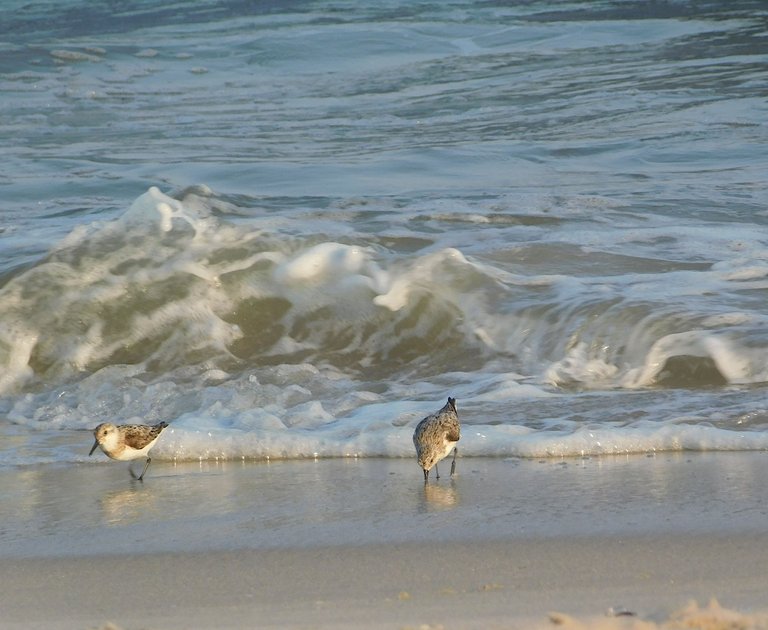
agmoore
This summer I made a delightful discovery on a New York (USA) beach: the Sanderling (Calidris alba). The first thing I noticed about the small shorebird was its "obsessive wave chasing" (description offered by Cornell University site, All About Birds). The next thing I noticed about the frisky bird was that it congregated in large groups.
When I researched the behavior of Sanderlings, my informal observations about their habits were confirmed. Animal.net explains: "Sanderlings are social birds, and usually congregate in flocks....all the birds keep an eye out for predators. If one spots a predator, it alerts the rest of the flock and all the birds quickly take off into the air."
The chief predator of Sanderlings, outside of their nesting grounds, is the falcon.
Wave-chasing Sanderlings
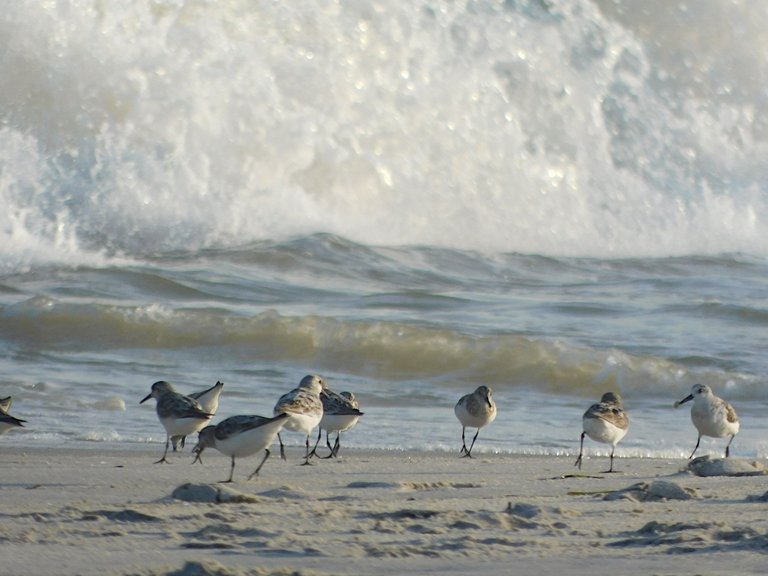
agmoore
It was obvious the birds' frenetic scurrying about was in pursuit of food. They would run as a wave crashed and then stick their long beaks deep into the sand as the wave pulled out.
Sanderlings Hunting for Food in the Wake of a Retreating Wave
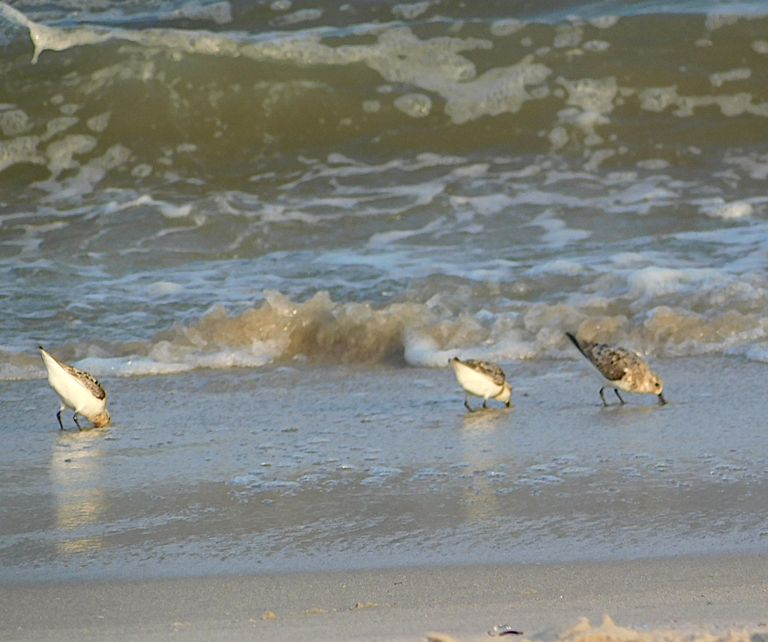
agmoore
I examined the sand to look for the food they were extracting. I did find minute sand crabs, and small gelatinous creatures that looked like baby jelly fish.
Tiny Holes Where Crabs Burrowed in the Sand, and Salps It was hard to catch the birds with something in their beaks, but I did capture a picture of one that was in the process of collecting food. The food appeared to be one of the baby jellyfish creatures. Sandpiper With Salp in its Grasp Up-close viewing of the tiny creatures revealed that they were, indeed, living organisms. With a some online research I discovered their name: salps. These chordate animals (means they have a dorsal nerve chord) are taxonomically closer to humans than than they are to jellyfish. Salps are so interesting that I will probably dedicate a future blog to them. I also researched the Sanderling diet, and discovered that Sanderlings are adaptive when it comes to food. They are omnivores. They eat plants and animals, vertebrates and invertebrates. They even eat biofilm, which is a living organism sort of in a category on its own. Often referred to as slime, or sea scum, this organic material is a major part of the shorebird's diet. Here is a Youtube video of a Sanderling foraging for sand crabs on a California beach (Video by Alicia's Moments in Nauture.)

agmoore
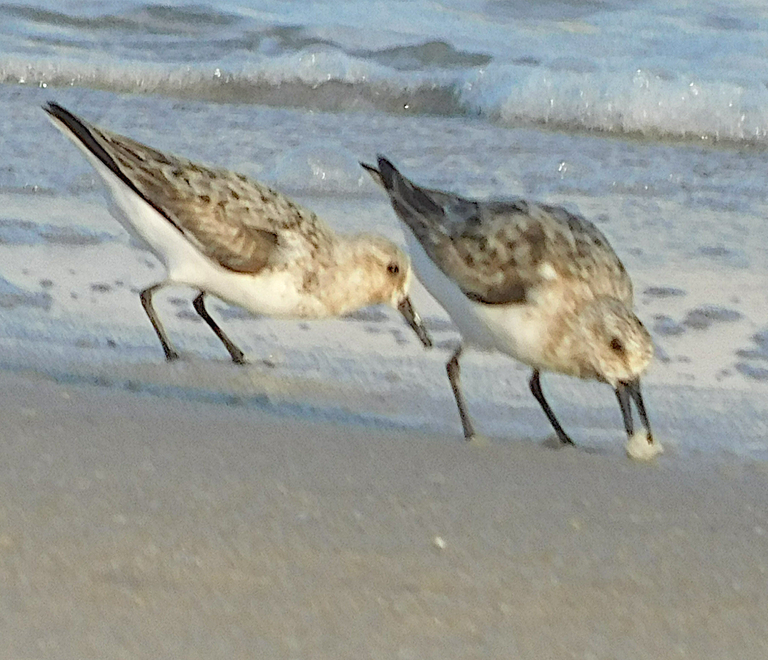
agmoore
Because foraging Sanderlings sometimes share a beach with humans, their behavior adapts somewhat to the potential danger of a human presence. Predictably, Sanderlings that often forage near humans may show a greater tolerance of this proximity, but in all cases a human approach can disrupt feeding. It was my personal observation at the beach, that the Sanderling is not as approachable as a gull, but is also not especially skittish.
This Sanderling didn't seem overly alarmed as I took its picture.
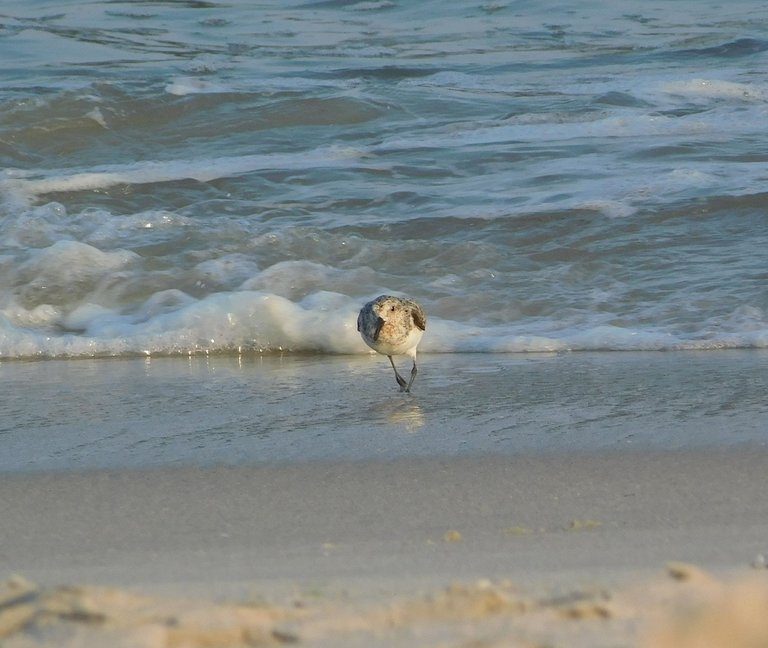
agmoore
While the Sanderling is one of the most common birds in the world, there have been reports of significant population declines in the Americas. These declines are believed to be attributed to climate change, which has disturbed their nesting areas in the Arctic, and also to destruction of shore habitat through pollution and development.
Classification
Phylum: Chordata
Class: Aves
Order: Charadriiformes
Family: Scolopacidae
Genus: Calidris
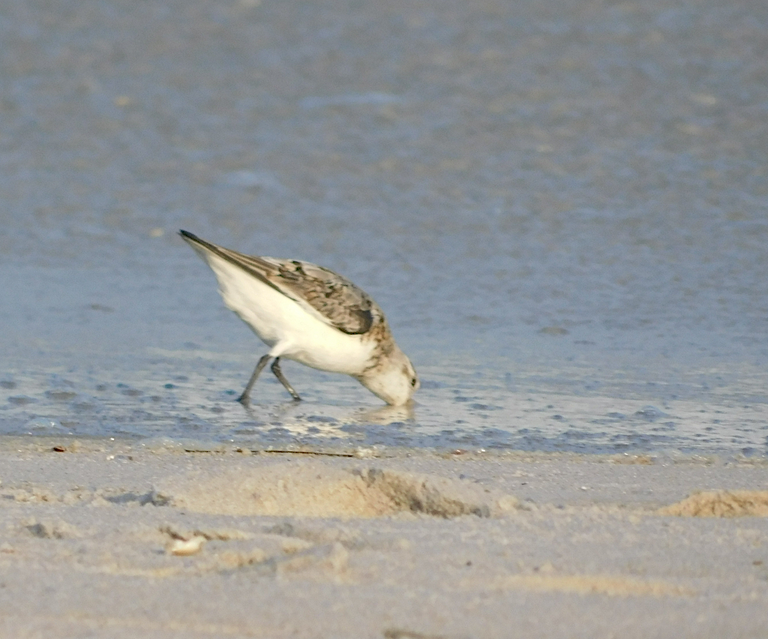
agmoore
The Sanderling is a sandpiper, in the family Scolopacidae. This is a family of shorebirds that generally breeds in the north and migrates long distances. The family includes sandpipers, curlews, phalaropes, and godwits (from Birdweb). In North America alone there are at least 22 species of sandpiper.
The Sanderling is the only sandpiper without a hind toe. According to several sources, this allows the small shorebird to run quickly.
Sanderling Walking: Absence of Hind Toe
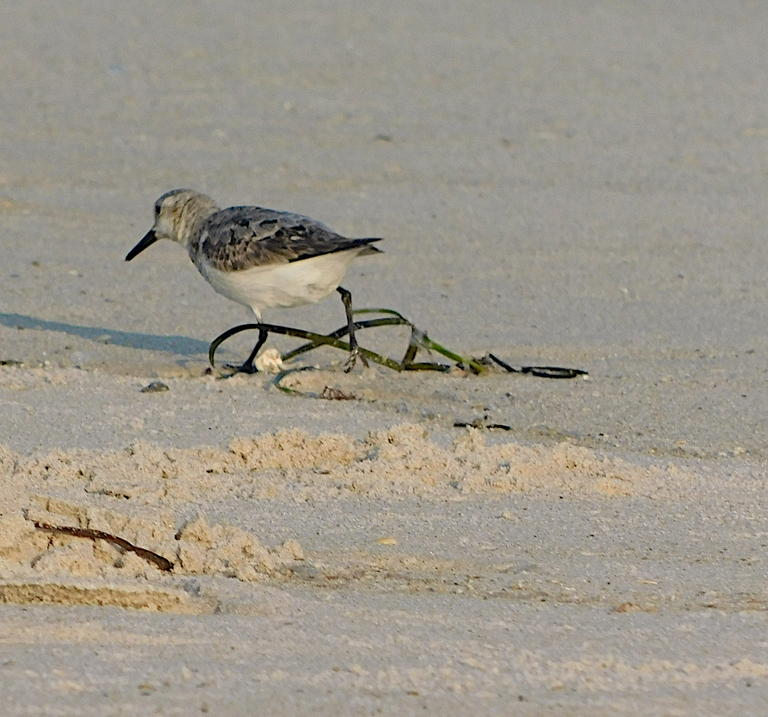
agmoore
Reproduction and Migration
The tiny Sanderling has a migration pattern that rivals the Monarch butterfly's epic journey from Canada to Mexico. The Sanderling begins its life in the Arctic. The bird is a "circumpolar breeder in high arctic regions in Alaska, arctic Canada, north and east Greenland, Svalbard and western and central Siberia." (From the Norwegian Polar Institute.)
When breeding, Sanderlings change their plummage. Below is a picture of an adult breeding Sanderling.
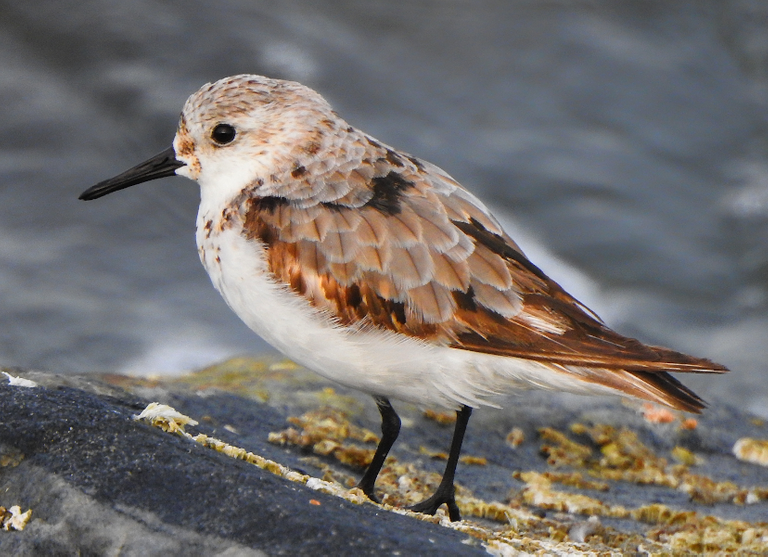
Credit: Afsarnayakkan. Used under CC 4.0 International license.
The bird has been described as monogamous, polyandrous, polygynous and polygynandrous. There may be variations in the mating habits, depending (it is surmised) on the region in which the birds nest. Nests are on the ground, with perhaps some leaves spread around. Four eggs are laid, sometimes two clutches (separate group of four eggs). If a second clutch is laid, the male pitches in and helps to incubate one of them. Incubation may take approximately a month. By the time the young are about three weeks old, they are on their own.
Two Sanderlings, Waiting for the Next Wave
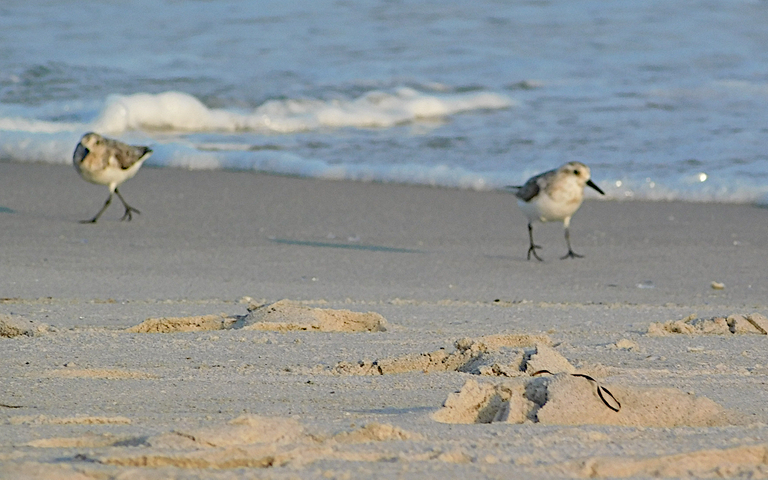
agmoore
The bird's migration takes it almost across the globe as it travels south in winter to shores in North America, South America, Europe, South Africa and Australia.
If you want to hear what Sanderlings sound like in flight, listen to this recording from the website British Bird Songs, UK. According to Animal Diversity.org, outside of the breeding season, Sanderlings are relatively quiet.
A Sanderling Walking on the Beach

agmoore
Lifespan
Sanderlings have been known to live 13 years. A recent study published in the Journal of Animal Ecology suggests that survival rates for the bird may be influenced by migratory distance. Birds that migrate to equatorial regions have poorer outcomes than those that migrate to areas south and north of the equator.
Anther factor that influences the survival of the birds and the success of their broods is the date of snow melt in the breeding grounds. A late melt can have a devastating effect on bird and brood survival. There may not be enough food to sustain the birds or their young, and the young may perish in the cold.
As is true of other wildlife, loss of habitat and pollution are also threats to the Sanderling. In North Carolina (USA) the bird is a 'species of concern'.
Three Sanderlings on the Beach

agmoore
These birds have few defenses against predators. Their colors help to camouflage them. They also call out to each other and their young when danger is perceived. The response of a flock may be to take to the skies. The response of threatened young Sanderlings is likely to be that the threatened bird freezes in place and hopes to escape notice.
A Sanderling Extracting Some Sort of Food From the Surf
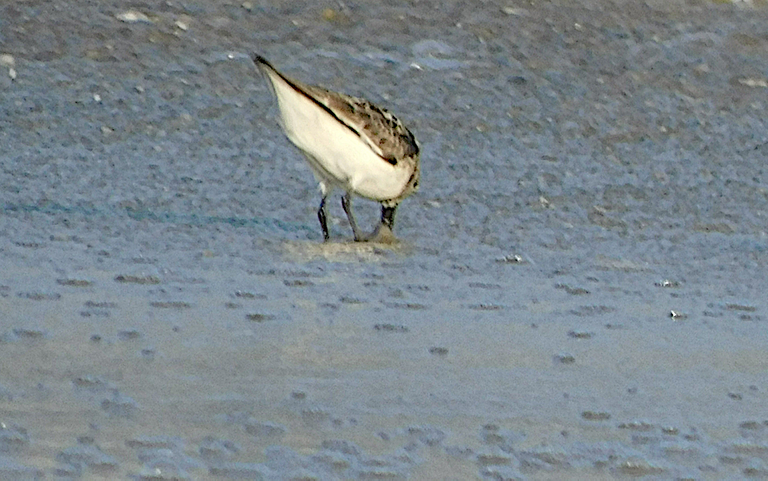
agmoore
Conclusion
I hope you have enjoyed reading about this little shorebird. When I first saw Sanderlings I thought they were terns. I didn't know much about terns or Sanderlings. The more I read about Sanderlings, the more interesting they become. Though this may be the last time I write about this bird on Hive (who knows?), it certainly will not be the last time I study them.
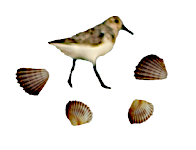
Resources
Illustration at the end of the blog: Shells: @muelli from LIL, the LMAC Image Library. The bird was extracted from one of my photos.
***All photos not otherwise credited were taken by me.
1.https://www.allaboutbirds.org/guide/Sanderling/overview
2.https://animals.net/sanderling/
3.https://interpretivecenter.org/salps-a-mystery-on-the-beach/
4.https://australian.museum/learn/animals/sea-squirts/what-is-a-salp/
5.https://www.researchgate.net/publication/325093726_The_food_web_perspective_on_aquatic_biofilms
6.https://digitalcommons.coastal.edu/cgi/viewcontent.cgi?article=1334&context=honors-theses
7.https://abcbirds.org/bird/sanderling/
8.https://climateactiontool.org/species/sanderling
9.https://www.chesapeakebay.net/discover/field-guide/entry/sanderling
10.https://goodheartextremescience.wordpress.com/2010/01/27/meet-the-amazing-salp/
11.https://academic.oup.com/bioscience/article/49/9/689/246823
12.https://www.eopugetsound.org/magazine/biofilm
13.https://www.youtube.com/channel/UCf6BfLjfjRXlrUA4Fr_tSow
14.https://birdweb.org/birdweb/family/scolopacidae
15.https://www.birds-of-north-america.net/sandpipers.html
16.https://imbirdingrightnow.com/2019/05/28/answers-bird-quiz-3-loafing-shorebirds/
17.https://monarchjointventure.org/monarch-biology/monarch-migration
18.https://www.npolar.no/en/species/sanderling/
19.https://animaldiversity.org/accounts/Calidris_alba/
20.https://www.british-birdsongs.uk/sanderling/
21.https://besjournals.onlinelibrary.wiley.com/doi/full/10.1111/1365-2656.13187
22.https://www.arctictoday.com/unusual-late-spring-snow-devastated-shorebirds-northeast-greenland/
23.https://sites.google.com/site/savetheshorebirdsnc/species-list/sanderling
24.http://www.biokids.umich.edu/critters/Calidris_alba/
Yes! Aren't they fascinating? Another discovery about ever-amazing nature.
Thank you for stopping by and reading my post.
It is undoubtedly a very beautiful species of bird. Apparently its survival is based on constantly migrating to different areas in search of food sources and better places to reproduce. It is a pity that, like many animals, their lives are harmed by human action, especially by the garbage that often contaminates the beaches and that on many occasions end up being ingested by the birds. Very nice photos and are complemented by excellent information @agmoore. A pleasure to read you again, greetings.
Greetings, @abneagro,
Thank you for the nice words. For me, your posts are a model for how to do a blog about nature. Of course, you know so much and I have to research everything :))
Those little birds are amazing. They have to constantly balance energy used against energy gained when they forage. Even when they take flight to avoid predators, they have to balance energy used against danger.
I'm glad you like the photos. Some are fuzzy, but still clear enough to see. Thanks again for stopping by. Have a most wonderful day.
https://twitter.com/A_G_Moore/status/1571179698692018185
The rewards earned on this comment will go directly to the people( @agmoore ) sharing the post on Twitter as long as they are registered with @poshtoken. Sign up at https://hiveposh.com.
Nice photography!!
its cool!!
Thank you! It was fun to write.
It's so nice and interesting reading about this beautiful creature here, the sanderlings.
It's surprising how these birds are able to coordinate themselves and look out for each others faithfully without rancor or unnecessary competition. Infact, one may say that they are even more sincere and coordinated than humans in this regards 😅.
Well, indeed nature is beautiful. I love the sight of the sea shore. Thanks alot for sharing this wonderful blog.
They do get along, don't they? I as surprised to see that they also got along pretty well with the gulls on the beach. There didn't seem to be any competition...maybe because they were not looking for the same food source.
I appreciate your kind comment and your support of my blog.
That's great. You are welcome
So educative. So sad that the sanderling numbers are declining. Hope they pick back up again though. You say the Sanderling's migration rivals that of the Monarch butterfly and I find that impressive based in the weight differences. Do the Sanderling's fly Non-stop during Migration?
According to the Audubon Society, the birds make "long nonstop flights between key stopover points". I suppose that means they must stop on the journey and then continue. I guess they need to refuel in order to continue flying.
Thanks for coming by. It seems all wildlife suffer from competition with human activity. We are not very good at sharing the earth, are we?
Actually, we claim to be above nature but we still follow the same rules; Survival of the fittest. Although we take it too far at times.
Beautiful piece on these cool birds. I like that you took a snapshot of the little holes in the sand. Very scientific. I don't think I have seen any sanderlings around these parts. Or maybe I just didn't know that's what they were called.
Thank you, @litguru! My granddaughter and I were fascinated by the little sand crabs. She kept trying to rescue them by sending them out to sea again😄
I found a couple of references to sightings of them on Vancouver Islands. Don't know how close that is to where you are.
https://gohiking.ca/animals/birds/shorebirds/sanderling/
They are cool birds, aren't they? It was a pleasure to watch them chase the waves.
It seems like the strong sense of empathy runs in the family 😃
The islands are relatively far, accessible by ferries, but given that the sanderlings are migratory birds, they may have stopped here on their way to their destination. I'll keep my eyes open when I'm hanging out at the beach.
As always a through and interesting writeup A.G. There is a bird here that looks similar called a sand piper. Perhaps just another name for the same bird,
I hope you are keeping well. Cooler weather settling in the last few days. Oh summer I miss you already! 😆
These are sandpipers! So, you probably see them. I believe you live on Prince Edward Island? Birds of Prince Edward Island: https://www.birdsofpei.info/p/sanderling.html
Thanks for visiting and commenting, dear @redheadpei. Weather is still wonderful here. Bright sun, some pleasant breeze. Actually, my favorite time of year.
Thanks A. G. I see they are from the sandpiper family. We had cool night but today looks to be starting nice and sunny here on PEI.
Have a wonderful week my dear friend, 😊
Very interesting and enjoyable article. Shore birding must be very refreshing because of the softness of the wet wind off the beach.
Because of everything you describe, those Sanderlings are very agile when it comes to escape from what they consider a threat. The best thing is that they eat those little jellyfish, they are not very nice when they sting our skin.... They, the Sanderlings, are very important animals for nature, as they help to maintain the balance of the ecosystem.
Thank you @agmoore for sharing your research with all of us.
Muy interesante y ameno tu artículo. La observación de aves costera debe ser muy refrescante por la suavidad del viento húmedo de la playa.
Debido a todo lo que describes, esos Sanderlings son muy agiles cuando se trata de escapar de lo que consideran una amenaza. Lo mejor del caso, es que se comen a esas pequeñas medusas, no son muy agradables cuando pican nuestra piel... Ellos, los Sanderlings, son animales muy importantes para la naturaleza, ya que ayudan a mantener el equilibrio del ecosistema.
Gracias @agmoore por compartir tu investigación con todos nosotros.
Thank you for stopping by, @maria1989. You are right, these little birds do help to keep the balance of nature. They prey on small creatures and are themselves prey. A vital part of the food chain. Plus they are beautiful :)
It is a pity that they, as is true of many animals, suffer because of habitat loss.
Thanks again for your comment. Have a great week!
I promised myself to visit a real beach before the end of this year and I really hope that I am able to fulfill that promise to myself. Getting to see one of these sanderlings for myself would be great, seemed like they were really poising for those cute shots to be taken.
There did seem mostly unaware of our presence, unless we got really close. The gulls on the beach I think were posing.😄 Gulls are characters.
I did enjoy these birds very much. I hope you do get to the beach. The surf and the wind remind us that we really are a part of nature.
Thanks very much for visiting.